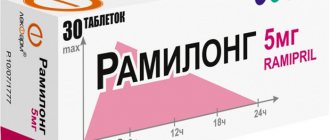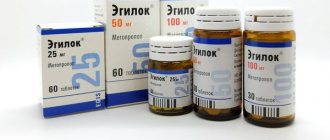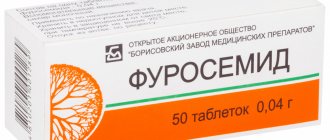Pharmacodynamics and pharmacokinetics
The active components of this drug are used for high blood pressure.
Ramiprilat (the active metabolite of ramipril ) inhibits ACE . In addition, it leads to a decrease in the release of aldosterone . Ramipril also causes a decrease in peripheral vascular resistance .
In most cases, the antihypertensive effect is noticeable within 1-2 hours. It lasts for 24 hours. The maximum degree of severity of the effect is achieved after 3-6 hours. With long-term therapy, the maximum effect is usually noticeable after about 3 weeks. With a long-term course of treatment, it is maintained for 2 years.
Hydrochlorothiazide is a thiazide diuretic . Possible patterns of its antihypertensive action include changes in sodium balance and renal vascular resistance, as well as decreases in extracellular fluid, plasma, and responses to angiotensin II and norepinephrine .
The maximum effect is noticeable after 3-6 hours and lasts up to 12 hours. The antihypertensive effect is achieved after 3-4 days of therapy and lasts a week after completion of the course. With long-term therapy, a decrease in blood pressure is achieved by using smaller dosages than needed for a diuretic effect. The decrease in blood pressure is accompanied by a slight increase in glomerular filtration renin activity in the blood plasma, as well as vascular resistance of the renal bed . When hydrochlorothiazide in high dosages, plasma volume decreases, as does glomerular filtration , mean arterial pressure , and renal blood flow. With long-term therapy in small doses, blood plasma volume, systemic vascular resistance and mean arterial pressure remain quite low, while the glomerular filtration and minute volume return to their previous values.
Hartil price, where to buy
The price of Hartil may vary depending on the form of release. So, the cost of 10 mg tablets, on average, is about 350 rubles. And the price of Hartil in 5 mg tablets is approximately 270 rubles.
- Online pharmacies in RussiaRussia
- Online pharmacies in UkraineUkraine
- Online pharmacies in KazakhstanKazakhstan
ZdravCity
- Hartil tablets 5 mg 28 pcs. CJSC Farm.zavod EGIS
387 rub. order
Pharmacy Dialogue
- Hartil (5 mg tablet No. 28) Egis
RUR 368 order
- Hartil (tab. 10 mg No. 28) Egis
RUR 461 order
show more
Pharmacy24
- Hartil 10 mg No. 28 tablets ZAT FZ EGIS / Aktavis LTD, Ugorshchina / Malta
169 UAH. order - Hartil-AM 10mg/5mg N30 capsules ZAT FZ Egis, Ugorshchina
148 UAH order
- Hartil-AM 5 mg/10 mg No. 30 capsules ZAT FZ EGIS/VAT Pharmaceutical plant EGIS, Ugorshchina/Ugorshchina
137 UAH order
- Hartil-N 2.5 mg/12.5 mg No. 28 tablets ZAT FZ Yegis, Ugorshchina/Alfamed Farbil Arznaimittel GmbH, Nimechchina
132 UAH order
- Hartil-N 5 mg N28 tablets ZAT FZ Yegis, Ugorshchina/Alfamed Farbil Arznaimittel GmbH, Nimechchina
163 UAH order
PaniPharmacy
- Hartil-N tablets Hartil-N tablets 2.5 mg/12.5 mg No. 28 Hungary, Egis
138 UAH order
- Hartil-N tablets Hartil-N tablets 5mg/25mg No. 28 Hungary, Egis
163 UAH order
- Hartil AM capsule Hartil AM 10mg/5mg capsules No. 30 Hungary, Egis
153 UAH order
- Hartil tablets Hartil tablets 5 mg No. 28 Hungary, Egis
121 UAH order
- Hartil AM capsule Hartil AM 5mg/10mg capsules No. 30 Hungary, Egis
155 UAH order
show more
Contraindications
This product is not recommended for use if:
- cholestasis;
- history of angioedema , as well as hereditary/idiopathic ;
- significant problems with kidney function;
- anuria;
- primary aldosteronism;
- hemodialysis;
- galactose intolerance ;
- hereditary lactase or impaired absorption of glucose-galactose ;
- breastfeeding;
- pregnancy;
- childhood;
- significant disturbances in liver function;
- arterial hypotension;
- condition after kidney transplantation;
- intolerance to the components of the drug.
Hartil-D is prescribed with caution for aortic and mitral stenosis , systemic connective tissue diseases, severe lesions of the coronary and cerebral arteries, decompensated cor pulmonale, severe ventricular arrhythmias, suppression of bone marrow hematopoiesis, bilateral artery stenosis , gout , hyponatremia , hypercalcemia , renal failure , cirrhosis of the liver , unstable angina , chronic heart failure (fourth stage), decreased volume of blood volume , diabetes mellitus , old age, hypertrophic obstructive cardiomyopathy , hyperkalemia , stenosis of the artery of a single kidney , hypokalemia , artery disease , liver failure .
Hartil®
Before starting treatment with ramipril, hyponatremia and hypovolemia must be corrected. In patients who have previously taken diuretics, it is necessary to discontinue them or at least reduce their dose 2-3 days before starting ramipril (in this case, the condition of patients with CHF should be carefully monitored, due to the possibility of their developing decompensation when increase in BCC).
After taking the first dose of the drug, as well as when increasing its dose and/or the dose of diuretics (especially loop diuretics), it is necessary to ensure careful medical monitoring of the patient for at least 8 hours so that appropriate measures can be taken in a timely manner in case of an excessive decrease in blood pressure.
If the drug is used for the first time or in a high dose in patients with increased activity of the RAAS, their blood pressure should be carefully monitored, especially at the beginning of treatment, since these patients have an increased risk of an excessive decrease in blood pressure (see section "With caution").
In case of malignant hypertension and heart failure, especially in the acute stage of myocardial infarction, treatment with ramipril should be started only in a hospital setting.
In patients with CHF, taking the drug can lead to the development of a pronounced decrease in blood pressure, which in some cases is accompanied by oliguria or azotemia and rarely by the development of acute renal failure.
Caution should be exercised when treating elderly patients, as they may be particularly sensitive to ACE inhibitors; it is recommended to monitor renal function in the initial phase of treatment (see also section Dosage and Administration).
In patients for whom a decrease in blood pressure may pose a certain risk (for example, in patients with atherosclerotic narrowing of the coronary or cerebral arteries), treatment should begin under strict medical supervision.
Caution should be exercised during physical activity and/or hot weather due to the risk of increased sweating and dehydration with the development of arterial hypotension due to a decrease in blood volume and a decrease in sodium concentration in the blood.
During treatment with ramipril, it is not recommended to drink alcohol (ethanol).
A transient excessive decrease in blood pressure is not a contraindication for continuing treatment after stabilization of blood pressure. In case of repeated development of a pronounced decrease in blood pressure, the dose should be reduced or the drug discontinued.
The simultaneous use of ramipril with drugs containing aliskiren or with ARA II, leading to double blockade of the RAAS, is not recommended due to the risk of excessive reduction in blood pressure, the development of hyperkalemia and deterioration of renal function compared with monotherapy. The simultaneous use of ramipril with drugs containing aliskiren in patients with diabetes mellitus and/or moderate to severe renal failure with creatinine clearance <60 ml/min is contraindicated (see sections Contraindications, Interactions with other drugs).
Concomitant use with ARA II in patients with diabetic nephropathy is contraindicated (see sections Contraindications, Interaction with other drugs).
Cases of angioedema of the face, extremities, lips, tongue, pharynx or larynx have been observed in patients treated with ACE inhibitors. If swelling occurs in the face (lips, eyelids) or tongue, or difficulty swallowing or breathing, the patient should immediately stop taking the drug. Angioedema, localized in the area of the tongue, pharynx or larynx (possible symptoms: difficulty swallowing or breathing), can be life-threatening and requires urgent measures to relieve it: subcutaneous administration of 0.3-0.5 mg or intravenous drip of 0.1 mg of epinephrine (adrenaline) (under the control of blood pressure, heart rate and ECG) followed by the use of glucocorticosteroids (iv, intramuscular or orally); Intravenous administration of antihistamines (H1 and H2-histamine receptor antagonists) is also recommended, and in case of insufficiency of C1-esterase enzyme inactivators, the need to administer C1-esterase enzyme inhibitors in addition to epinephrine (adrenaline) can be considered. The patient should be hospitalized and monitored until symptoms are completely relieved, but not less than 24 hours.
Cases of intestinal angioedema, manifested by abdominal pain with or without nausea and vomiting, have been observed in patients receiving ACE inhibitors; in some cases, angioedema of the face was simultaneously observed. If a patient develops the symptoms described above during treatment with ACE inhibitors, the possibility of developing intestinal angioedema should be considered when making a differential diagnosis.
Treatment aimed at desensitization to insect venom (such as bees, wasps) and concomitant use of ACE inhibitors can initiate anaphylactic and anaphylactoid reactions (eg, decreased blood pressure, shortness of breath, vomiting, allergic skin reactions), which can sometimes be life-threatening. During treatment with ACE inhibitors, hypersensitivity reactions to insect venom (such as bees, wasps) develop faster and are more severe. If desensitization to insect venom is necessary, the ACE inhibitor should be temporarily replaced with a corresponding drug from another group.
Life-threatening, rapidly developing anaphylactoid reactions, sometimes leading to shock, have been described with the use of ACE inhibitors during hemodialysis or plasma filtration using certain high-flux membranes (for example, polyacrylonitrile membranes) (see also membrane manufacturer's instructions). The combined use of ramipril and the use of this type of membrane, for example, for emergency hemodialysis or hemofiltration, should be avoided. In this case, it is preferable to use other types of membranes or avoid taking ACE inhibitors. Similar reactions were observed with low-density lipoprotein apheresis using dextran sulfate. Therefore, this method should not be used in patients receiving ACE inhibitors.
In patients with impaired liver function, the response to treatment with ramipril may be either enhanced or weakened. In addition, in patients with severe liver cirrhosis with edema and/or ascites, significant activation of the RAAS is possible, so special care should be taken when treating these patients (see also section Dosage and Administration).
Before surgery (including dental surgery), it is necessary to warn the surgeon/anesthesiologist about taking ACE inhibitors.
It is recommended to closely monitor neonates exposed in utero to ACE inhibitors for hypotension, oliguria, and hyperkalemia. In oliguria, it is necessary to maintain blood pressure and renal perfusion by administering appropriate fluids and vasoconstrictors. These neonates are at risk of developing oliguria and neurological disorders, possibly due to decreased renal and cerebral blood flow due to the decrease in blood pressure caused by ACE inhibitors.
Monitoring laboratory parameters before and during treatment with ramipril up to 1 time per month in the first 3-6 months of treatment
Monitoring kidney function (determining serum creatinine concentrations)
When treating with ACE inhibitors, it is recommended to monitor renal function in the first weeks of treatment and subsequently. Particularly careful monitoring is required in patients with acute and chronic HF, impaired renal function, after kidney transplantation, patients with renovascular diseases, including patients with hemodynamically significant unilateral renal artery stenosis in the presence of two kidneys (in such patients, even a slight increase in serum creatinine concentration may be an indicator decreased kidney function).
Electrolyte control
Regular monitoring of serum potassium and sodium concentrations is recommended. Particularly careful monitoring of potassium concentration in the blood serum is required for patients with impaired renal function, significant disturbances in water and electrolyte balance, and CHF.
Monitoring of hematological parameters (hemoglobin, number of leukocytes, erythrocytes, platelets, leukocyte formula)
It is recommended to monitor the complete blood count to identify possible leukopenia. More regular monitoring is recommended at the beginning of treatment and in patients with impaired renal function, as well as in patients with connective tissue diseases or in patients simultaneously receiving other drugs that can change the peripheral blood picture (see section Interactions with other drugs). Monitoring the number of leukocytes is necessary for the early detection of leukopenia, which is especially important in patients with an increased risk of its development, as well as at the first signs of infection. If neutropenia is detected (the number of neutrophils is less than 2000/μl), discontinuation of treatment with ACE inhibitors is required.
If symptoms due to leukopenia appear (for example, fever, enlarged lymph nodes, tonsillitis), urgent monitoring of the peripheral blood picture is necessary. If signs of bleeding appear (tiny petechiae, red-brown rashes on the skin and mucous membranes), monitoring the number of platelets in the peripheral blood is also necessary.
Determination of the activity of “liver” enzymes, the concentration of bilirubin in the blood
If jaundice or a significant increase in the activity of “liver” enzymes appears, treatment with the drug should be stopped and medical supervision of the patient should be provided.
Hartil® tablets 2.5 mg, 5 mg and 10 mg contain lactose.
If you are lactose intolerant, you should take into account its content in each tablet: Hartil® 2.5 mg - 158.8 mg, Hartil® 5 mg - 96.47 mg, Hartil® 10 mg - 193.2 mg.
This drug should not be used in patients with rare hereditary galactose intolerance, hereditary lactase deficiency, or glucose-galactose malabsorption syndrome.
Side effects
When taking the drug at the beginning of therapy and after increasing dosages, severe arterial hypotension . Symptoms such as dizziness , blurred vision, general weakness, and fainting are possible. In addition, isolated cases of dynamic cerebrovascular accident, tachycardia , arrhythmias , myocardial infarction , palpitations, severe arterial hypertension , angina pectoris and shock have been reported. When using ACE inhibitors with arterial hypotension, cerebral hemorrhage and ischemic stroke .
The following adverse reactions are also possible:
- metabolism - hyperglycemia , increased acid levels, hypokalemia , gout , hyperkalemia , hypomagnesemia , hypercalcemia , hyponatremia , hyperchloremia ;
- nervous system – apathy , nervousness, headache , fatigue, feeling of weakness, drowsiness ;
- organs of vision - conjunctivitis , blepharitis ;
- cardiovascular system - significant decrease in blood pressure , swelling of the ankles;
- respiratory system - the appearance of a dry cough, bronchitis ;
- digestive system - nausea, vomiting, abdominal pain, dyspepsia epigastric cramps , constipation , dullness of appetite, thirst, diarrhea ;
- skin - urticaria , photosensitivity , itching ;
- urinary system - proteinuria ;
- reproductive system - decreased libido.
In rare cases, it is possible:
- circulatory system and lymph - decrease in hematocrit and hemoglobin , thrombocytopenia , eosinophilia , leukopenia , pancytopenia , agranulocytosis , hemolytic anemia (in case of deficiency of glucose-6-phosphate dehydrogenase );
- metabolism and nutrition - improper water-electrolyte balance, metabolic alkalosis , hypochloremia , increased levels of triglycerides in the blood serum and serum amylase , hypercholesterolemia , decompensation of diabetes mellitus ;
- nervous system - anxiety, imbalance, sense of smell, paresthesia ;
- organs of vision - transient myopia;
- hearing organs - ringing in the ears;
- cardiovascular system - dynamic cerebrovascular accident, fainting, thromboembolic complications , vasculitis , thrombosis , exacerbation of Raynaud's disease , venous disease, embolism ;
- respiratory system - shortness of breath, rhinitis , glossitis , allergic interstitial pneumonia , sinusitis , pharyngitis , bronchospasm , Quincke's edema , pulmonary edema;
- digestive organs - intestinal obstruction, dry mouth, taste disturbance, sialadenitis , vomiting, inflammation of the mucous membranes, hemorrhagic pancreatitis ;
- liver - increased activity of bilirubin and liver enzymes, cholestatic jaundice , cholecystitis , hepatitis , liver necrosis
- skin - systemic lupus erythematosus , erythema multiforme , facial flushing, peripheral edema, increased sweating, Lyell's syndrome , exacerbation of psoriasis , Stevens-Johnson syndrome , allergic reactions , alopecia , onycholysis ;
- musculoskeletal system and connective tissue - muscle spasm, arthralgia , arthritis , myalgia , muscle weakness, paralysis ;
- urinary system - deterioration of kidney function, dehydration, increased levels of residual nitrogen and serum creatinine , nephrotic syndrome , acute renal failure , oliguria , interstitial nephritis ;
- reproductive system - impotence ;
- others - anaphylactic reactions.
Quincke's edema in most cases appears in patients of the Negroid race. In addition, a small group experiences angioedema of the face and oropharyngeal area due to the use of ACE inhibitors .
In case of pronounced side effects on the skin, you should consult a specialist.
Medical observation is indicated for jaundice liver enzyme activity .
Instructions for use Hartil-D (Method and dosage)
The medicine is intended for single use in the morning with a sufficient amount of liquid. The instructions for use of Hartil-D indicate that food intake does not affect its action. Tablets cannot be cut into pieces.
You should take this medication only after your doctor has selected the dosage and regimen. As a rule, to start the course, 2.5 mg of ramipril and 12.5 mg of hydrochlorothiazide . The maintenance dosage is the same or twice as high, respectively, for each active substance. The dose is increased if necessary with a minimum interval of 3 weeks. The recommended maximum dosage per day is 5 mg ramipril and 25 mg hydrochlorothiazide .
For elderly people, as well as for those who have problems with the kidneys and liver, the doses of each component are selected individually before switching to the combined drug Hartil-D. Its dosage should be minimal.
Indications for use
Indications for use of this product are as follows:
- arterial hypertension;
- diabetic nephropathy;
- chronic diffuse kidney diseases;
- the need to reduce the risk of myocardial infarction and “ coronary death ” in people with coronary artery disease ;
- heart failure after acute myocardial infarction with stable hemodynamics ;
- chronic heart failure ;
- the need to reduce the risk of stroke in people with coronary artery disease .
For arterial hypertension Hartil Amlo can also be used if, before switching to this medicine, blood pressure was controlled by the simultaneous use of ramipril and amlodipine in the same dosages as in the drug.
Overdose
When using this drug in excess dosages, the following are possible: urinary retention, significant decrease in blood pressure , convulsions, arrhythmia , shock, intestinal obstruction, electrolyte imbalance, coma , paresis , bradycardia , renal failure .
The treatment regimen is selected individually. As general measures, gastric lavage, sodium sulfate and activated charcoal may be prescribed. In addition, maintenance therapy is used.
Ramipril is removed from the body through dialysis .
If there is a significant decrease in blood pressure, fluid volume is restored with saline. If this does not give the desired result, intravenous administration of angiotensin II and catecholamines . It is very important to monitor BCC , acid-base balance , diuresis , electrolyte and glucose levels in the blood. With severe bradycardia , a pacemaker is installed. If hypokalemia , potassium levels should be restored to normal.
For life-threatening angioedema, the following measures are taken:
- subcutaneous administration of up to 0.5 mg of epinephrine or slow intravenous administration of Adrenaline with monitoring of ECG and blood pressure ;
- administration antihistamines ;
- intravenous or intramuscular administration of glucocorticoids ;
- adrenaline can be supplemented with a C₁-inactivator if the patient has a deficiency.
Overdose of the drug Hartil, symptoms and treatment
Symptoms: severe hypotension, shock, electrolyte imbalance, renal failure. Treatment of overdose depends on how and when the drug is administered, as well as the type and severity of symptoms. Treatment: general measures - gastric lavage, use of sorbents, sodium sulfate (if possible during the first 30 minutes). It is necessary to monitor and support the vital functions of the patient’s body in intensive care conditions; for hypotension, you can also administer catecholamines and angiotensin II, place the patient on his back with the foot end of the bed elevated, and administer additional fluid and sodium. Hemodialysis is ineffective.
Interaction
The combination of ramipril and diuretics may lead to an enhanced antihypertensive effect. In addition, a significant decrease in blood pressure . So it is advisable to avoid this combination.
The hypotensive effect may be enhanced when ramipril concomitantly with organic nitrates or vasodilators . In addition, it is weakened by the use of NSAIDs . to impaired renal function in combination with ramipril In rare cases, renal failure . The risk of its development increases when Hartil-D is taken simultaneously with Allopurinol ( leukopenia ) and Cyclosporine . The latter remedy, as well as Lovastatin and trimethoprim, can also cause hyperkalemia . Leukopenia also develops when Hartil-D is combined with Procainamide , immunosuppressants and cytostatics .
The interaction of ramipril with lithium preparations leads to an increase in the level of lithium in the blood serum, and the development of toxic effects is possible. This combination is not recommended, but if it is unavoidable, monitoring of the patient's condition is required. Lithium toxicity may be exacerbated by the use of thiazide diuretics .
Arterial hypotension is enhanced by the interaction of ramipril with certain anesthetics , antipsychotics and tricyclic antidepressants .
The patient's condition should also be monitored when Hartil-D is combined with sympathomimetics . And when interacting with hypoglycemic agents, their effect may increase until hypoglycemia . This is especially possible when starting therapy and in cases of renal impairment.
The combination of dialysis with ACE inhibitors is contraindicated, as this can lead to anaphylactoid reactions.
Hydrochlorothiazide, when interacting with Amphotericin B , GCS , laxatives, Carbenoxolone or Corticotropin , can lead to electrolyte imbalance. And when combined with calcium salts, the appearance of hypercalcemia , with cardiac glycosides - digitalis intoxication and hypokalemia , with Sotalol - arrhythmia , with salicylates - an increase in their toxic effect on the central nervous system.
The absorption of hydrochlorothiazide is reduced by the action of cholestyramine resins and Colestipol . Therefore, between taking them it is necessary to leave a gap of one to several hours.
This active substance Hartil-D also enhances the effect of non-depolarizing muscle relaxants .
In addition, the antihypertensive effect of the drug is reduced when combined with sodium chloride.
Hartil's analogs
Level 4 ATC code matches:
Dilaprel
Prenesa
Enap
Diroton
Lipril
Renipril
Parnavel
Fozinap
Tritace
Enam
Zokardis
Fosinopril
Lisinopril
Captopril
Monopril
Renitek
Phosicard
Amprilan
Ramipril
Perindopril
The following analogues of Hartil can be found in pharmacies:
- Ampril;
- Anghiram;
- Euroramipril 10;
- Euroramipril 5;
- Ramag;
- Rami Sandoz;
- Ramigexal;
- Ramizes;
- Ramimed;
- Ramira;
- Tritace.
They all have different prices. The price of analogues varies depending on the manufacturer and the form of release of the drugs. As a rule, their cost is slightly lower than Hartil, which is similar in dosage and release form. Only Ampril , produced in Slovenia, is more expensive.





